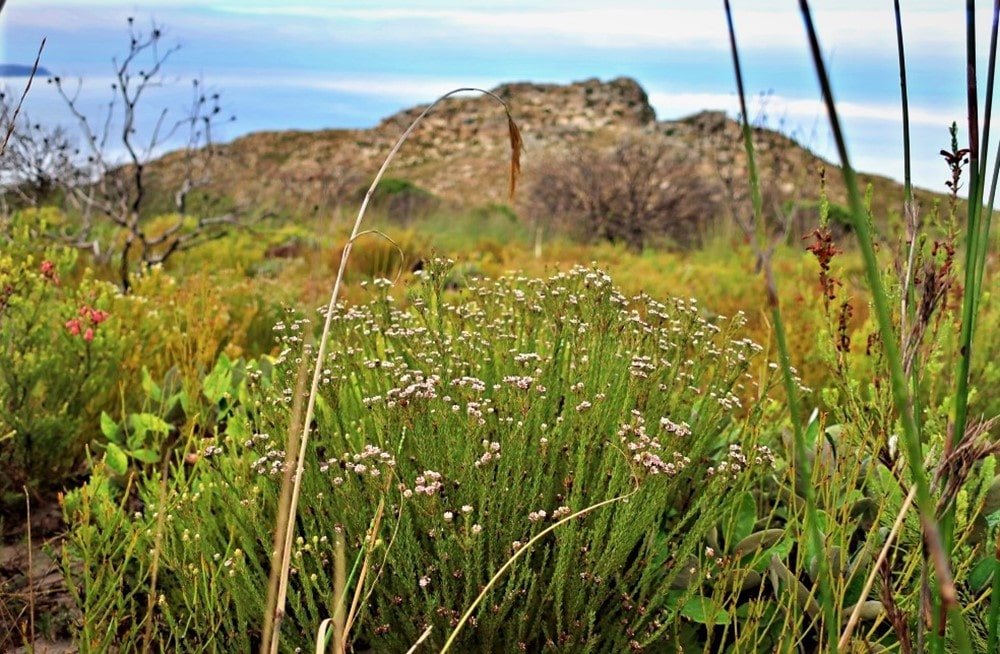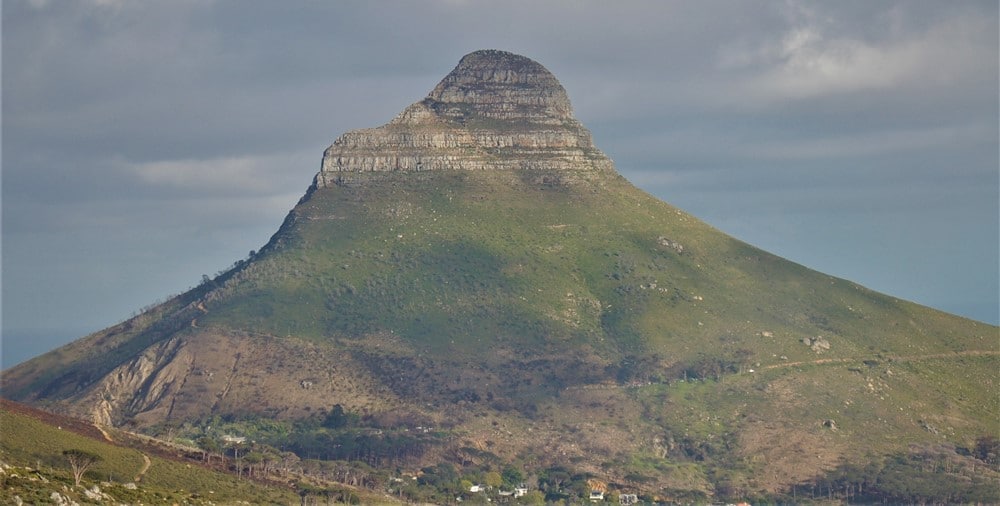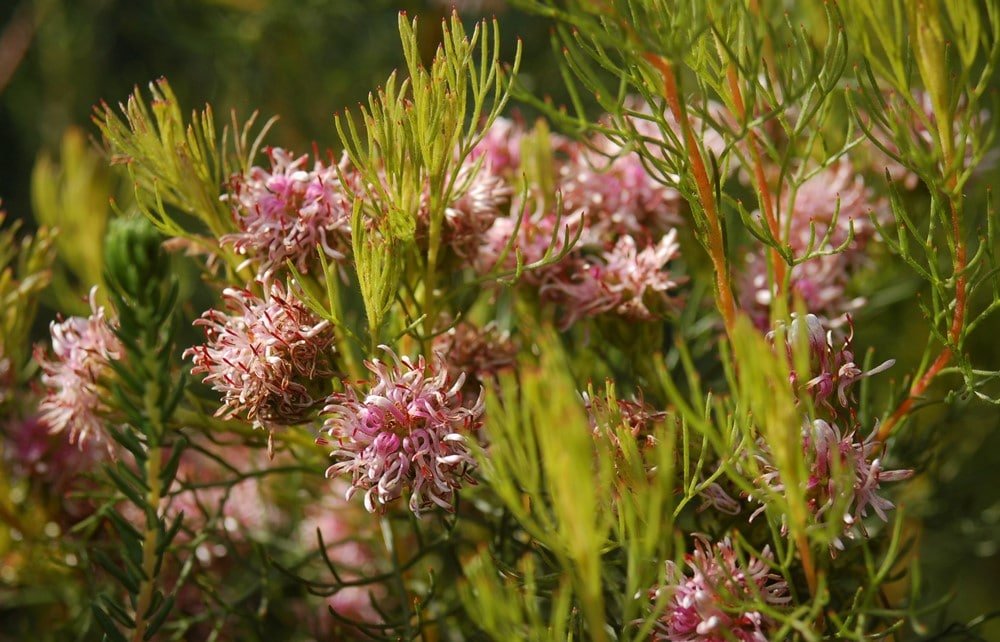Let’s first get the bad news out of the way: identification of fynbos plants is not easy. There are, as you know, thousands of plant species in the mountains of the Western Cape and they come from many different families – some of which you know (like the Iris, Daisy and Pea families) and some of which you might not (Penaea and Brunia for example).
And to make things worse, although plant species change with bewildering rapidity as you walk through fynbos, the general appearance of the vegetation does not. Compared to rainforests with their diverse mix of huge trees and understorey shrubs, ferns and looping vines, the fynbos landscape – bushy and reedy – is pretty much the same whether you are hiking at 1500 metres or next to the ocean.

Fynbos has a reputation for floral diversity but it’s not always apparent at first glance; the changes in vegetation are often subtle.
Now the good news. Fynbos is the most studied vegetation type outside Europe; its floral extravagance has captivated naturalists for centuries and there are books, websites, NGOs, nurseries and clubs dedicated to just about every aspect of fynbos you can think of.
But first you start here.
FYNBOS IDENTIFICATION STEP ONE: MAKE SURE YOU ARE IN FYNBOS
It sounds a bit obvious but the natural environment in the Western Cape is super-diverse (the province is home to half of South Africa’s fauna and flora species) and fynbos is just one of the different plant communities here. There is also Renosterveld and Afro-montane Forest plus Strandveld and – as you head north – drier regions with succulent vegetation and other desert-like plants.
And the physical distance between these plant communities – ‘biomes’ is the proper word – is sometimes just a few footsteps. There’s no point turning the pages of a fynbos field guide if you are looking at plants on Signal Hill above Cape Town. It might look like fynbos – it’s bushy – but that’s renosterveld vegetation and there’s very little species crossover between these plants and the neighbouring fynbos plants a short distance away on Lion’s Head.

Identifying plants on Lion’s Head depends where you are standing: there’s sandstone fynbos at the top; granite fynbos in the middle & clay-based renosterveld below the road. Ignore the alien trees.
There are, however, two giveaways that signal you are in fynbos. Firstly, these are plants that stick to sandstone. Exceptions exist of course – there are fynbos communities on granite and limestone – but these are rare or remote and the general rule applies: if you are on the mountains of the Western Cape and their immediate hinterland – even by the ocean – and there are plants around you, then you should be in fynbos.

Fynbos is the biome that dominates the sandstone mountains in the Western Cape – even if the mountains have tumbled down to sea level like here in Rooi Els in the Overstrand.
The second giveaway will confirm it: look for Restios – the Cape Reeds. Restios are the lowest common denominator in fynbos; there may not be any proteas or heathers or flashy orchids where you are but there will always be a restio of some kind. To a large extent they take the place of grasses in fynbos and the more you see of them, the tougher the environment. Don’t worry about the different types of restio – they are notoriously hard to identify as individual species – but you will notice that they form the backdrop to fynbos and are mostly absent from other Cape vegetation types such as renosterveld.

The bronze-orange flower heads of Restios stud the fynbos landscape & often form giant fields called ‘restio plains’.
FYNBOS IDENTIFICATION STEP TWO: WHERE ARE YOU?
I know you are in the mountains but where? Fynbos plants tend to be localised; many are found only in specific regions or habitats so huge numbers of possible identifications can be dismissed if you check the distribution maps of a field guide. And South Africa does have an amazing range of flower field guides, including a set for the fynbos region that concentrates on key areas such as Table Mountain and Cape Point as well as the mountains of the Winelands and Whale Coast.
The localisation of fynbos plants can be extreme. If you want to see Staavia doddi, a lanky shrub with silver flowers, then you have to go to 300-metre stretch of low-lying sandstone above a beach in the Cape of Good Hope Reserve. And keep your eyes open for a mile or two as you drive along the R44 between Gordon’s Bay and Rooi Els – that’s the only place you’ll see Leucospermum bolusii, a pincushion protea with creamy white flowers. Even famous fynbos plants can be limited to precise locations. Don’t look for the Silver Tree (Leucadendron argenteum) in the fynbos of the Cederberg mountains; it only occurs on granite soil on the Cape Peninsula. But Rooibos Tea (Aspalathus linearis) refuses to grow anywhere except the Cederberg – you’ll never see it on Table Mountain.

There’s no point in identifying Serruria aemula unless you are in swampy ground on the Cape Flats to which it is completely restricted.
FYNBOS IDENTIFICATION – STEP THREE: WHAT DOES THE LEAF LOOK LIKE?
The design of fynbos plants – their size, the shape and colour of their leaves, their general appearance – is driven primarily by an overriding need to save water. Sure they need to deal with fire and predators and so on, but it’s the conservation of water in a predominantly hot, windy and dry environment that determines what they look like. And that’s best reflected in their leaves.
Fynbos has of course many succulents – plants that store water in their leaves or stems like Aloes and Ice Plants or Vygies (Aizoaceae family) – and these are relatively easy to identify as such. But when it comes to the good old-fashioned green leaf, then fynbos plants have worked out that there are three types of leaf that best withstand the rigours of the merciless Cape dry season – or ‘summer’ as we like to call it.
Ericoid leaves – these are the classic needle-like leaves: usually small, thin, stunted and with their edges often rolled over to shade their stomata, their breathing pores. This design ensures minimum exposure to the sun and is the business model favoured by the famous Erica (heather) family – hence the word ‘ericoid’. The problem is that it works too well and it’s a design employed by many other plant families in fynbos from Daisies to Brunias but if you are confronted by a non-descript bush with tiny thin leaves, at least you have a starting point: it’s an ericoid.

The ericoid leaves & heathery-coloured flowers might make you think “Erica!” but this ericoid shrub is Muralita spinosa in the Polygala family.
Proteoid leaves – no prizes for guessing which plant family gave this design its name. Proteoid leaves are big, flat and tough – they feel like leather or plastic – and are held vertically to reduce exposure to the sun. Many of the biggest leaves are fringed in red as extra protection from the sun. It’s a common design in the Protea family but one also found in the Daisy family for example and is usually seen on bigger shrubs at lower altitudes.

These are proteoid leaves – thick & leathery – but this is no protea; it’s Sea Lavender (Limonium scabrum) in the Plumbago Family.
Restioid leaves – we met the Restios above – the Cape Reeds – and one of the reasons for their success in fynbos is their leaf design: they don’t have any. By getting rid of their leaves and relying on a green stem to do the photosynthesis, Restios have hit on a very effective way to conserve water and it’s copied by several other plants including members of the Iris family.

There’s no mistaking Bobartia indica as an Iris when in flower but it sits on tall reedy stems with no leaves – easy to think it’s a restio or sedge.
FYNBOS IDENTIFICATION – STEP FOUR: IS THERE A FLOWER?
Now we’re getting closer. The presence of a flower is a huge step towards identifying a fynbos plant and is easier than you think. Plants are put into their respective families – Protea, Erica, Daisy – based on their flower structure. Forget what the plant itself looks like – it’s the flower that determines what they are. Take Senecio crassulaefolius for example; hanging off rocks on Lion’s Head, its fat grey leaves immediately bring to mind a cactus-like succulent but it is – somewhat inevitably – yet another daisy thanks to its simple compound flower structure.

Fynbos plants like Senecio crassulaefolius have you thumbing through pages of succulent families until it flowers & reveals itself as a member of the Daisy family.
You’ll see it all through fynbos: the flat spiky leaves of Arctopus echinatus would never make you think of a carrot but when it blooms in the Cape winter, you’ll see the classic umbrella-shaped flower that so characterises the Carrot family – Umbelliferae. Other familiar flowers are there too – you can’t mistake a flower from the Pea family or the Orchid family for example – and you’ll soon pick out the familiar shapes of geraniums, gentians and irises, their flowers reminding you of the stuff you have in the garden back home.
THE NEXT STEP …
Now you just need to practice. Don’t worry about identifying plants to a species level; focus instead on familiarising yourself with the major families (“that’s a Protea, that’s a Daisy, that’s an Iris”) and the genera (the next level down) – “that’s a type of Serruria in the Protea family” – will come pretty quickly. And then the species start arriving – “I’m at Cape Point in low mountains and so that must be Serruria Villosa” – and, finally, it all starts to make sense.

So helpful! Thank you!
You are welcome – and thank you for reading it!
Hello Dominic
Very interesting read!
Im studyimg to become a nature guide in the fynbos biome.
I live near Montagu in great fynbos country and are in the mountains often. However there are not alot of people around with great knowledge in fynbos to help me with id and info.
Would love to walk the mountains with an expert. Can you help?
Hello Willem – I’m very glad you are training to be a guide though to get in business you may need to move a little further to Cape Town! I’m not often out there but when you come to Cape Town next give me a shout. And if you haven’t already, get yourself a copy of John Manning’s Fynbos field guide for the general view, and the relevant flower guide to your area.
Very useful and practical
Thanks. A similar article for cape bulbs would also be useful.
Thank you Richard – and that’s a great idea: A Beginner’s Blog on Bulbs – there’s a title there already! Thanks for the inspiration.
As always, GREAT article Dom… thanks for making it so simple
Thank you my brother, kind words – oh, we must go strolling on the slopes of Devil’s Peak this spring; that renosterveld area will be very interesting after this fire!
Great article. I moved to the Western Cape (George) a few months ago and I am on the trails overlooking George almost daily. I’ve just read a few of your posts and have already made a huge leap in my flower learning – thank you! I didn’t realise that Ericas are part of the Heathers and that they are not completely separate. And this four-point guide to identification – a winner!
When I hit the trails tomorrow I’m going apply what I’ve learned to looking at leaf and flower shape to get a feel for what it going on out there.
I’m loving the flowers and the recurrent blooms that seem to happen. Super, informative blog – I’ll definitely jump into reading more of what you have written. Very much appreciated.
I’m delighted it’s helping: feel free to email me with ID requests – keeps me on my toes. And wait until you see what happens to fynbos after the winter rains have kicked in.
Great read! Really enjoy the way you write. Straight to the point. Just started informing myself on fynbos and your article is an immense help. Going to email you a pic for identification please 🙏.
Thanks for very helpful article,we bought Fynbos Gin in Germany wanted to know what Fynbos really ist.
We Plan to visit Cape Town to have a closer look!!!!
Thank you, and I hope you can make your visit here: you will find that fynbos gin tastes even better when you are surrounded by fynbos!
Hello Dominic
Thank you for the great read.
My son is busy with his NQF2 course. He has passed his theory, but still needs to do his practical assessment, early November at The Tygerberg Nature reserve.
We have done the Duiker Trail, took lots of phot’s, but need help with identifying the plants.
Could you please assist?
Kind regards
Amelia
Hello Amelia
Thank you – and you are quite welcome to send me photos of the plants – email them to me at thefynbosguy@gmail.com or if there are lots, perhaps dropbox it? The Tygerberg is mostly renosterveld so it will be a good challenge for the Fynbos Guy!
Thank you Dominic, for this article. I’m reading it in an airport lounge, en route to the Western Cape for the first time. I feel so much more empowered to understand what I will be seeing – much less intimidated by a flora that I have only seen out of context in botanical gardens. Robert
And I promise you it gets easier! Once one realises that it is indeed all a bit ‘samey’, then the details become more apparent.
This was such an inspiring article. I live close to Montagu and often walk the trails. Just git the Fynbos field guide and enjoy it. Visit Onrus and surroundings so learning slowly but surely.
Thank you for your pointers, it is of great help and less frustrating.
Hi there
Would you recommend an ID guide for fynbos. Thanks!
Hi Yusuf – yes I would; there are two ways to go – if you are a beginner, get the Wild Flower guide to the Cape Peninsula by Hugh Clark. It is arranged by colour of flower and a great way to get started. Then there is John Manning’s Fynbos field guide, both an abridged and full version.